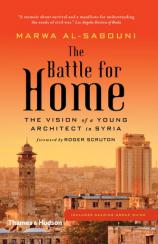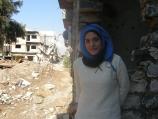Reading Group Guide
Discussion Questions
The Battle for Home: The Vision of a Young Architect in Syria

1. What did you know about Syria --- its culture, its people, its civil war and the aftermath --- prior to picking up THE BATTLE FOR HOME? Did you have any preconceived ideas about the country or its people’s struggle? How did Marwa al-Sabouni’s story and ideas inform or change your opinion, if at all?
2. The Syrian city of Homs was one of the first cities to rise up against the country’s government in 2011. Not long after those protests started, fighting erupted in the streets. Eventually more than 60 percent of the city was destroyed. During that time, hundreds of thousands of people fled their homes. But some, like al-Sabouni and her family, stayed. Given the risks involved with either decision, what do you think you would’ve done if you were in her circumstances: stay or go?
3. THE BATTLE FOR HOME is al-Sabouni’s memoir of life in Syria. It’s also an in-depth look at the role architecture plays in a city’s identity. Think about the place where you live. How does the built environment interact with the natural one? Are there ways in which the two complement each other? Are there ways in which they clash? How does their relationship inform how well your city or town runs as a whole?
4. al-Sabouni explains that Syrians have an expression that basically means: “One who has no old has no new.” What does that saying mean to you? Is it valid? Why or why not?
5. In the Foreword, Roger Scruton describes “the idea of a city in which prosperous and poor, old and young, Muslim and Christian, live peacefully side by side, in streets that they share, beneath a skyline respectful of their religious aspirations.” Do you think this vision is possible for Syria as it rebuilds? For cities in America? What would it take to make this dream a reality?
6. In the first chapter, al-Sabouni writes that after the conflict, many people in Syria wished things could “go back to the way they were,” to a time before so much had been lost. She reflects on why they wouldn’t, instead, wish for better --- especially after all they had risked. If you were living in Homs, Aleppo, Damascus, or any comparable cities in Syria during the Arab Spring and its aftermath, would you join the fight for change knowing it could potentially destroy your home? Is the fight for progress and freedom justified if so many lives are lost?
7. In Chapter 1, al-Sabouni writes, “Freedom has become so unfree. For many it represents no more than a green light to sound off on social media, disrespecting anything and anyone as much as they like.” Do you agree with this statement? Why or why not?
8. al-Sabouni suggests that the downfall of Homs and other Syrian cities was an architectural failure as much as it was a social and political one --- that poor urban planning and land management contributed to the cities’ destruction. How well do you think she proves her thesis? Could she have done anything differently to make her argument more convincing?
9. In Chapter 4, al-Sabouni writes, “Craft products educate us to strive for commitment and allow us to know what it is like to contribute.” Furthermore, “the value of craft doesn’t reside simply in providing essential products for city life; it lies in the way the products are made, and the subliminal education that emanates from them, which is…essential for any flourishing society.” In western culture when new is often preferred to used, what is the value of the artisan lifestyle? What subliminal education do we receive when we buy products that are made by hand?
10. In Chapter 5, al-Sabouni asks, “How can an architect create Home in any building when he himself has never experienced it; when all that he has seen around him is trampled life that seeks relentlessly to emerge?” Given what you have learned about Syria in THE BATTLE FOR HOME, how might you answer that question? What would make it possible for architects like al-Sabouni to create a Syrian Home in the future?
11. al-Sabouni uses the phrase “we are all human” throughout the book. What does that statement mean to you? Do you incorporate that philosophy into your life? If so, how? If not, why not?
12. al-Sabouni proposes that “modern architecture prefers to control a place, rather than to respect it.” Do you agree with her assessment? Are there architects working today whose work might suggest otherwise?
13. Dozens of black-and-white sketches are included throughout THE BATTLE FOR HOME. How do these drawings augment your understanding of al-Sabouni’s story and theories?
14. If you were to pick an architect or architectural style you admired most, who or what would it be and why?
15. al-Sabouni has a PhD in Islamic architecture and runs a private architectural studio in Holms. Were you surprised to learn that women in Syria are given equal opportunities in education and the workforce?
16. It’s tricky to know “the truth” about a culture if you’ve never spent a long amount of time immersed in it. If you could ask al-Sabouni one question about “the truth” of her life in Syria, what would it be? Alternatively, if there was one thing you wished she could know about your life in America or elsewhere, what would it be and why?
The Battle for Home: The Vision of a Young Architect in Syria
- Publication Date: September 19, 2017
- Genres: Cultural Studies, Current Affairs, Memoir, Nonfiction
- Paperback: 208 pages
- Publisher: Thames & Hudson
- ISBN-10: 0500292930
- ISBN-13: 9780500292938







